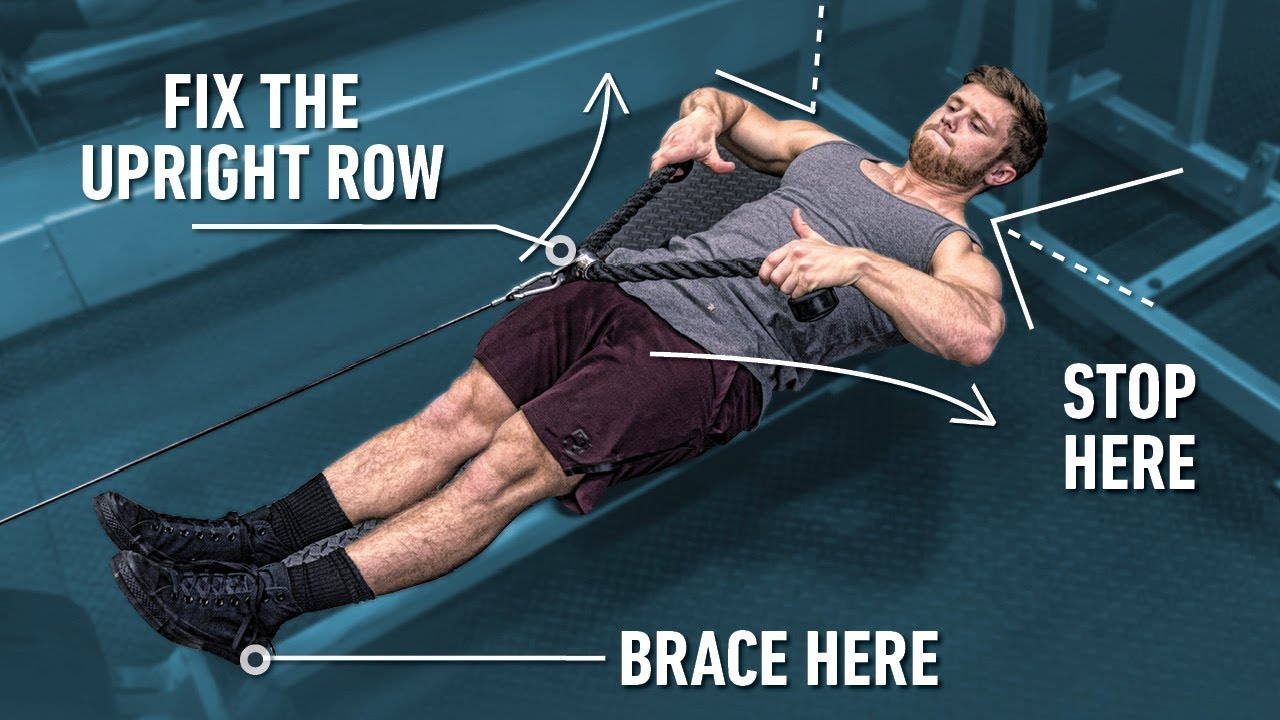The upright row has long been a controversial exercise in bodybuilding circles. Some athletes swear by it for building impressive shoulders, while others avoid it due to concerns about shoulder impingement. The truth? When performed correctly, the upright row can be one of the best compound movements for targeting the lateral deltoids—a muscle group that is often overshadowed by front delt–dominant pressing exercises.
In this guide, we’ll break down the biomechanics of the upright row, explain how to execute it safely, share key injury-prevention tips, and explore several variations to help you get the most out of this movement.

Why the Upright Row Deserves a Place in Your Routine
Most compound shoulder exercises, such as the overhead press or bench press, emphasize the anterior deltoid. The upright row, however, shifts focus to the side delts, which are primarily responsible for giving the shoulders their wide, rounded appearance.
Muscles Worked
- Lateral Deltoids (Primary) – Activated through shoulder abduction, similar to a lateral raise.
- Upper Trapezius (Secondary) – Engaged during scapular elevation, helping lift the shoulders upward.
- Biceps (Minor Contribution) – Assist with elbow flexion, although their involvement is minimal.
While the upper traps do get some stimulation, they are better trained through dedicated shrugs. For delt-focused growth, the upright row remains a top choice when executed correctly.
The Shoulder Impingement Debate
One of the biggest criticisms of the upright row is its potential to cause shoulder impingement, a condition where the space between the shoulder bones narrows, compressing the tendons of the rotator cuff. According to an NSCA report, shoulder injuries make up around 36% of weightlifting-related injuries, so proper technique is crucial.
The risk arises when the arms are raised above shoulder height in an internally rotated position. However, research suggests the upright row can be both safe and effective when performed with the following modifications.
3 Key Technique Adjustments to Keep Shoulders Healthy
- Keep the Bar Close to the Body
Holding the bar close reduces unnecessary shoulder stress and keeps the movement within the scapular plane—a natural arc for the shoulder joint. - Pull With the Elbows, Not the Hands
Focus on driving your elbows outward and upward instead of yanking the weight with your wrists. A good mental cue: “Row out and up, not straight up.” This helps emphasize the lateral delts while minimizing trap dominance. - Limit the Range of Motion
Studies show that impingement most commonly occurs between 70–120 degrees of shoulder elevation. To stay in a safe zone, stop pulling when your elbows reach shoulder height or when your upper arms are parallel to the floor.
Optimizing Grip Width for Maximum Delt Activation
Grip width plays a major role in which muscles are emphasized. A 2013 EMG study by McAllister et al. found that a slightly wider-than-shoulder-width grip resulted in greater lateral delt activation compared to narrow or shoulder-width grips.
- Ideal Grip Width: Around 1–1.5 times shoulder width
- Experiment with Comfort: Every lifter’s shoulder structure differs, so adjust slightly to find a grip that feels natural while maintaining good mechanics.
Best Variations of the Upright Row
One of the great things about the upright row is its versatility. Different equipment and angles can reduce shoulder strain and enhance delt recruitment.

1. Standing Rope Upright Row (Cable Variation)
This variation allows for greater freedom of movement at the shoulder joint compared to a barbell.
How to Perform:
- Attach a rope handle to a low cable pulley.
- Use a double overhand grip and stand with a stable stance (a staggered stance works well).
- As you pull upward, separate the rope handles slightly to externally rotate the shoulders, further targeting the side delts.
- Stop when elbows align with or slightly below shoulder level.
2. Lying Cable Upright Row
By sitting or leaning against a bench while using cables, you eliminate momentum, forcing the delts to do all the work. This strict variation is ideal for hypertrophy-focused lifters.
3. Single-Arm Dumbbell Upright Row
Training one side at a time improves mind-muscle connection and helps correct muscular imbalances. Brace against an incline bench with your free hand for support, then lift the dumbbell out to the side with a controlled motion.
4. Band-Resisted Upright Row
Resistance bands change the tension profile, making the movement easier at the bottom and harder at the top. Use this variation as a warm-up or high-rep finisher to pump blood into the delts.
Reps, Sets, and Programming Tips
Because the upright row is a compound movement, moderate rep ranges work best:
- Primary Working Sets: 8–12 reps, 3–4 sets
- Hypertrophy Finishers: 12–15+ reps with lighter weight or bands
- Tempo: Controlled, with a 1–2 second concentric and 2–3 second eccentric phase
Avoid excessively heavy loading that forces you to use momentum from your hips or lower back, as this shifts tension away from the delts.
Common Mistakes to Avoid
- Pulling Too High
Going beyond shoulder height increases impingement risk without significantly improving delt activation. - Turning It Into a Front Raise
Lifting the weight too far forward shifts tension to the front delts, defeating the purpose of the exercise. - Using Momentum
Jerking the weight up reduces muscle engagement and can strain the lower back. - Neglecting Shoulder Position
Keep your shoulder blades retracted and depressed (pulled back and down) to protect the rotator cuff.

Where to Place the Upright Row in Your Workout
The upright row works best as a secondary compound movement after heavy pressing. A sample shoulder session could look like this:
- Overhead Press (Heavy Compound) – 4×6–8
- Upright Row (Delt-Focused Compound) – 3×8–12
- Lateral Raises (Isolation) – 3×12–15
- Face Pulls or Rear Delt Flyes – 3×12–15
Alternatively, you can use lighter variations, such as band or rope upright rows, at the end of a workout to finish off the delts.
The Bottom Line
The upright row has unfairly earned a bad reputation due to shoulder impingement fears. However, when performed with proper form, a moderate range of motion, and an appropriate grip width, it can be one of the most effective exercises for widening the shoulders and building impressive lateral delt thickness.
Experiment with different variations, pay attention to your body’s feedback, and always prioritize form over weight. Done correctly, the upright row can become a staple movement for rounded, capped shoulders.



